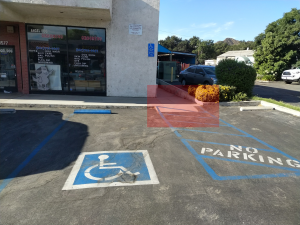What are your readily achievable barrier removal responsibilities?
I completed my first inspection in 2005. I was a certified inspector, had the credentials required, and knew what I needed to know, right? Not quite. Since then, I’ve come to understand that there is often more to what I don’t know than there is to what I do know. Never stop asking questions! For better or worse though, Code and law change regularly. It can be difficult to keep up. So, what responsibilities are you unaware of?
Here’s one for starters. According to California Building Code (Title 24), if you don’t alter a space, you are not required to perform any upgrades. The same is absolutely not true for ADA. This might be why federal suits accounted for over 80% of all ADA lawsuits in California in 2018 and why prelitigation letters dropped by 97% year over year.* There is no grandfather clause…not really.

Why? Readily achievable barrier removal, that’s why. So, what is this readily achievable barrier removal you ask? It’s covered in 28 CFR § 36.304 – Removal of barriers.
Existing conditions you are unsure about?
Settle your mind. Schedule a CASp inspection today.
Contact us today to schedule an inspection.
§ 36.304 Removal of barriers, (a) General:
A public accommodation shall remove architectural barriers in existing facilities, including communication barriers that are structural in nature, where such removal is readily achievable, i.e., easily accomplishable and able to be carried out without much difficulty or expense.
The law can be read in entirety here. There are 21 examples included, but the examples are not intended to be all encompassing. The law continues to elaborate providing suggestions for which areas should be addressed first. Renovations should generally be addressed in the following order:
1. Providing access to public accommodations from public sidewalks, parking, or public transportation.
2. Providing access to areas of public accommodation where services are made available to the public.
3. Providing access to restroom facilities.
4. Providing access by providing any other measures necessary to provide access to the goods, services, facilities, privileges, advantages, or accommodations of a place of public accommodation.
Give it to me simple…what does this really mean you ask? It means businesses are required to continually remove barriers that may restrict a disabled individual from using their business’ services. Businesses cannot wait until they want to renovate to remove barriers. They are responsible to remove access barriers sooner than later. If the parking lot does not meet ADA requirements, you are required to make it accessible as soon as possible. If your front entrance does not meet minimum requirements, you are required to upgrade it. If your aisles are too narrow, you are required to widen them. If your restrooms are not compliant, you are required to bring them into compliance. This is where a CASp shines. A CASp should help you determine the extent of barrier removal required, which barriers to address first, and with your assistance, should be able to help you establish a schedule and appropriate budget. When are you required to complete these upgrades you ask?! Honestly, it depends.

You are required to complete the upgrades when it is readily achievable, *if* the construction was compliant when installed. When the business has the means to complete the upgrades depends on funds, impact, schedule, existing construction…it can be complicated. The longer you wait to complete the upgrades though, the harder it is to argue a barrier was not readily achievable to remove. ADA has been around for nearly 30 years at this point. My building is not nearly 30 years old, so everything is fine, right? Possibly (probably, if your searching our site) not. Non-compliant construction is installed everywhere. Boot-leg construction is in progress everyday. Building inspectors have a job because people make mistakes. If construction was not compliant at the time of installation, and a barrier exists or is constructed, your business is required to correct the installation immediately. All businesses are susceptible to lawsuits, but non-compliant barriers leave businesses vulnerable.
1 in 3 Afghanistan and Iraq war vets are considered disabled. They served us. Let’s ensure we can serve them.
Reach out to us today to schedule an inspection.
Numbers from the 2018 California Commission on Disability Access. See our post regarding the 2018 report here.

